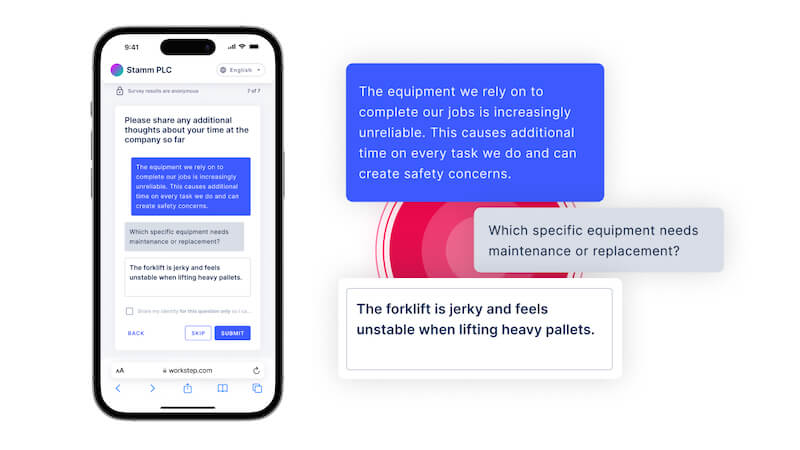Workforce Management Strategies
How to increase frontline workforce productivity: strategies for operations leaders
June 28, 2024
How can operations leaders increase frontline worker productivity? For effective frontline workforce operations management, we recommend investing in purpose built-technologies, employee communications and engagement, frontline leadership development, job satisfaction, and measurement of key performance metrics.
Frontline workers are the backbone of any organization, playing a critical role in customer interaction, service provision, and day-to-day operations. These five strategies will help you become a better frontline operations manager or site leader and improve your workforce’s productivity.
Invest in purpose-built technologies
Specialized tools tailored to the needs of frontline workers can significantly enhance their productivity. Purpose-built technologies address the unique challenges these workers face, making their tasks easier and more efficient. Investing in user-friendly and accessible technologies reduces the time frontline workers spend on administrative tasks, allowing them to focus on their core responsibilities. These technologies are easy to learn, minimizing the need for extensive training and ensuring all workers can benefit from them, regardless of technical skill.
Examples of purpose-built technologies include Customer Relationship Management (CRM) systems, which help manage customer interactions and provide personalized service, Inventory Management Systems that assist in tracking inventory levels and managing orders, and mobile devices that provide flexibility, allowing workers to access real-time information and communicate with customers and colleagues from anywhere.
Communication and transparency
Employee communication apps and engagement solutions, like WorkStep, help operations leaders understand pain points from the frontline workforce and decide where new purpose-built technologies need to be implemented. Open and transparent communication channels are crucial for effective operations management. Ensuring that workers have timely access to necessary information empowers them to make informed decisions and take ownership of their work.
Leveraging frontline employee communication solutions that include key features like one-to-many segmented communications, reachability analysis, and employee listening options facilitate real-time collaboration, enabling frontline workers to connect easily with colleagues, share ideas, and resolve issues promptly. A culture of open communication encourages employees to voice their concerns and suggestions, leading to valuable insights for process improvement and innovation. Regular feedback sessions, team meetings, and surveys provide opportunities for frontline workers to share their thoughts, enhancing morale and motivation.
Additionally, creating a culture of transparency improves quality assurance and safety, directly impacting operational efficiency. When employees feel heard and understood, they are more likely to share honest feedback about risks and hazards, adhere to safety protocols and contribute to a safer, more efficient work environment.
Invest in engaging and accessible leadership development
Developing leadership within your frontline workforce is critical for driving productivity and organizational success. Employee feedback data shows that lack of upward mobility within an organization is a cause of frustration for many. Engaging and accessible leadership development programs are essential, utilizing interactive e-learning modules, instructor-led workshops, on-the-job training, and mentoring programs.
Using data to identify high-potential and high-risk leaders is key. These insights empower leaders with the data they need to be effective. By investing in comprehensive leadership development, businesses can cultivate a pipeline of capable leaders and foster a culture of continuous improvement and excellence. Leveraging WorkStep’s employee experience platform ensures that leadership initiatives align with workforce needs, promoting long-term productivity and success.
Measure and improve job satisfaction
Job satisfaction is closely linked to productivity. WorkStep facilitates the measurement of job satisfaction through regular feedback collection and employee surveys. This feedback allows operations leaders to understand the factors contributing to job satisfaction or dissatisfaction among frontline workers. Addressing these factors, such as workload, communication, and recognition, helps improve overall job satisfaction. Unlike other tools, WorkStep is able to tie sentiment and job satisfaction to other key business outcomes, like turnover and retention. By providing actionable insights tied to real business outcomes, leads are able to take targeted action to address concerns in real-time.
Embrace data-driven decision-making
Your frontline workforce is your best source of data. Workforce visibility platforms, like WorkStep, provide real-time insights into performance so leaders can use workforce data to drive operational efficiency. Real-time data platforms help identify areas for improvement like training, scheduling, and resource allocation. In addition to collecting workforce data, these platforms must be able to tie workforce feedback to business outcomes to facilitate effective leadership decision-making. WorkStep’s platform leverages predictive analytics that go beyond sentiment to uncover business impact, boosting operational effectiveness and frontline workforce satisfaction. With real-time data tied to business outcomes, leaders can quickly identify issues as well as targeted solutions. By tracking individual and overall performance trends, leaders also optimize productivity and ensure frontline workers have the resources required to do their job effectively. Tracking the impact of data-driven decisions is also vital for evaluating resource allocation, labor forecasting, and labor management. Solutions like WorkStep help leaders directly track the impact of actions taken on topline business metrics like turnover and retention.
By implementing these workforce management strategies, operations leaders can significantly improve workforce productivity metrics. Investing in purpose-built technologies, prioritizing communication, revamping training programs, measuring job satisfaction, utilizing workforce visibility platforms, and embracing data-driven decision making will drive business growth and improve overall organizational performance.
Know the key indicators of poor frontline worker productivity
What does it take to measure and improve effective operations management? Pinpointing signs of lagging efficiency and implementing improvement measures are the first steps.
Kayla Pimentel, | kayla@workstep.com
Kayla Pimentel serves as a Demand Generation Associate at WorkStep. Leveraging her diverse background in sales and marketing, she is enthusiastic about sharing insights about how to make the frontline a better place to work.








